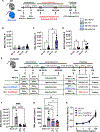Lung CD4+ resident memory T cells use airway secretory cells to stimulate and regulate onset of allergic airway neutrophilic disease
- PMID: 39965565
- PMCID: PMC12011213
- DOI: 10.1016/j.celrep.2025.115294
Lung CD4+ resident memory T cells use airway secretory cells to stimulate and regulate onset of allergic airway neutrophilic disease
Abstract
Neutrophilic asthma is a vexing disease, but mechanistic and therapeutic advancements will require better models of allergy-induced airway neutrophilia. Here, we find that periodic ovalbumin (OVA) inhalation in sensitized mice elicits rapid allergic airway inflammation and pathophysiology mimicking neutrophilic asthma. OVA-experienced murine lungs harbor diverse clusters of CD4+ resident memory T (TRM) cells, including unconventional RORγtnegative/low T helper 17 (TH17) cells. Acute OVA challenge instigates interleukin (IL)-17A secretion from these TRM cells, driving CXCL5 production from Muc5achigh airway secretory cells, leading to destructive airway neutrophilia. The TRM and epithelial cell signals discovered herein are also observed in adult human asthmatic airways. Epithelial antigen presentation regulates this biology by skewing TRM cells toward TH2 and TH1 fates so that TH1-related interferon (IFN)-γ suppresses IL-17A-driven, CXCL5-mediated airway neutrophilia. Concordantly, in vivo IFN-γ supplementation improves disease outcomes. Thus, using our model of neutrophilic asthma, we identify lung epithelial-CD4+ TRM cell crosstalk as a key rheostat of allergic airway neutrophilia.
Keywords: CD4(+) T cells; CP: Immunology; IFN-γ; MHC class II; T(H)17 cells; allergy; antigen presentation; epithelial cells; mucosal immunity; neutrophilic asthma; tissue-resident memory T(RM) cells.
Copyright © 2025 The Author(s). Published by Elsevier Inc. All rights reserved.
Conflict of interest statement
Declaration of interests The authors declare no competing interests.
Figures







References
-
- GBD 2015 Chronic Respiratory Disease Collaborators (2017). Global, regional, and national deaths, prevalence, disability-adjusted life years, and years lived with disability for chronic obstructive pulmonary disease and asthma, 1990–2015: a systematic analysis for the Global Burden of Disease Study 2015. Lancet Respir. Med. 5, 691–706. 10.1016/S2213-2600(17)30293-X. - DOI - PMC - PubMed
MeSH terms
Substances
Grants and funding
- F31 HL142199/HL/NHLBI NIH HHS/United States
- R01 HL165718/HL/NHLBI NIH HHS/United States
- R01 HG010883/HG/NHGRI NIH HHS/United States
- R33 HL137081/HL/NHLBI NIH HHS/United States
- R00 HL157555/HL/NHLBI NIH HHS/United States
- K99 HL159258/HL/NHLBI NIH HHS/United States
- K99 HL157555/HL/NHLBI NIH HHS/United States
- R01 HL111449/HL/NHLBI NIH HHS/United States
- R01 GM120060/GM/NIGMS NIH HHS/United States
- R35 HL135756/HL/NHLBI NIH HHS/United States
- R01 AI115053/AI/NIAID NIH HHS/United States
- T32 HL007035/HL/NHLBI NIH HHS/United States
- F32 HL147461/HL/NHLBI NIH HHS/United States
- R01 HL136725/HL/NHLBI NIH HHS/United States
LinkOut - more resources
Full Text Sources
Medical
Molecular Biology Databases
Research Materials
Miscellaneous

